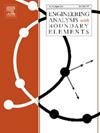A hybrid PSO-WO algorithm for identification of irregular inner wall defects of a body in a thermal environment
IF 4.2
2区 工程技术
Q1 ENGINEERING, MULTIDISCIPLINARY
Engineering Analysis with Boundary Elements
Pub Date : 2024-10-30
DOI:10.1016/j.enganabound.2024.106011
引用次数: 0
Abstract
Accurate knowledge of the inner wall defect shape of industrial thermal equipment (ITE) plays a crucial role in safety inspections. However, direct observation and measurement are challenging due to the high-temperature environment within ITE. To address this issue, the identification of irregular inner wall defect shape based inverse technology is studied in this work. A novel particle swarm optimization (PSO) coupled with the whale optimization (WO) algorithm (HPWA) is developed as solver for inverse problems to identify the inner wall defect irregular shape. This hybrid approach enhanced the late-stage convergence efficiency of WO while avoiding the local optima issue commonly faced by PSO. The radial integral boundary element method (RIBEM) is used for solving the transient heat transfer problem and obtain transient temperature data at measurement points for inverse problem simulations. It was chosen for its capability to effectively handle complex boundary shapes by discretizing only the domain boundaries. Additionally, the effect of the distance between outer and inner boundaries and measurement duration on the inverse results are thoroughly analyzed. Results show that the PSO-WO algorithm is robust to measurement errors and becomes more accurate with measurement points closer to the actual inner boundary position. Extending the measurement time has little effect on inversion results when the measurement period is long enough.
用于识别热环境中不规则人体内壁缺陷的 PSO-WO 混合算法
准确了解工业热力设备(ITE)的内壁缺陷形状在安全检查中起着至关重要的作用。然而,由于 ITE 内的高温环境,直接观察和测量具有挑战性。为解决这一问题,本工作研究了基于逆技术的不规则内壁缺陷形状识别。开发了一种新型粒子群优化(PSO)与鲸鱼优化(WO)算法(HPWA)相结合的逆问题求解器,用于识别内壁缺陷的不规则形状。这种混合方法提高了 WO 的后期收敛效率,同时避免了 PSO 通常面临的局部最优问题。径向积分边界元法(RIBEM)用于求解瞬态传热问题,并获取测量点的瞬态温度数据用于逆问题模拟。之所以选择 RIBEM,是因为该方法只对域边界进行离散化处理,能够有效地处理复杂的边界形状。此外,还深入分析了内外边界之间的距离和测量持续时间对反演结果的影响。结果表明,PSO-WO 算法对测量误差具有很强的鲁棒性,测量点越接近实际内边界位置,其精度就越高。当测量时间足够长时,延长测量时间对反演结果影响不大。
本文章由计算机程序翻译,如有差异,请以英文原文为准。
求助全文
约1分钟内获得全文
求助全文
来源期刊

Engineering Analysis with Boundary Elements
工程技术-工程:综合
CiteScore
5.50
自引率
18.20%
发文量
368
审稿时长
56 days
期刊介绍:
This journal is specifically dedicated to the dissemination of the latest developments of new engineering analysis techniques using boundary elements and other mesh reduction methods.
Boundary element (BEM) and mesh reduction methods (MRM) are very active areas of research with the techniques being applied to solve increasingly complex problems. The journal stresses the importance of these applications as well as their computational aspects, reliability and robustness.
The main criteria for publication will be the originality of the work being reported, its potential usefulness and applications of the methods to new fields.
In addition to regular issues, the journal publishes a series of special issues dealing with specific areas of current research.
The journal has, for many years, provided a channel of communication between academics and industrial researchers working in mesh reduction methods
Fields Covered:
• Boundary Element Methods (BEM)
• Mesh Reduction Methods (MRM)
• Meshless Methods
• Integral Equations
• Applications of BEM/MRM in Engineering
• Numerical Methods related to BEM/MRM
• Computational Techniques
• Combination of Different Methods
• Advanced Formulations.
 求助内容:
求助内容: 应助结果提醒方式:
应助结果提醒方式:


